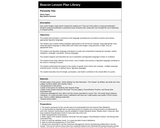
In this lesson, students study personification in published works of poetry, then create their own.
- Subject:
- English Language Arts
- Material Type:
- Lesson Plan
- Provider:
- Beacon Learning Center
- Author:
- Beacon Learning Center
- Date Added:
- 04/23/2019

In this lesson, students study personification in published works of poetry, then create their own.
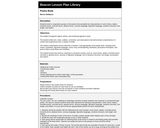
In this lesson, students work in cooperative groups to find poems that exemplify the characteristics of word choice, dialect, invented words, concrete terms, abstract terms, sensory language, figurative language, sentence structure, line length, and rhythm.

This is a lesson guide for "Cat!, Silver and Your World". In this CCSS lesson, students will explore this history through text dependent questions, academic vocabulary, and writing assignments.

Lesson guides for :Concrete, Harlem Night Song" and "The City is So Big". In this CCSS lesson, students will explore this history through text dependent questions, academic vocabulary, and writing assignments.

Lesson guides for "Old Man, Runagate Runagate" and "Blow, Blow, Thou Winter Wind". In this CCSS lesson, students will explore this history through text dependent questions, academic vocabulary, and writing assignments.
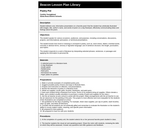
For this lesson, students deliver an oral, informative presentation on a favorite poem that the he/she has artistically illustrated with images, title, author's name, and words of poem on a clay flowerpot, effectively communicating ideas and feelings about the poem.

Possible Sentences is a pre-reading vocabulary strategy that activates students' prior knowledge about content area vocabulary and concepts. Before reading, students are provided a short list of vocabulary words from their reading, which they group and eventually use to create meaningful sentences. After reading, students check to see if their "possible sentences" were accurate or need revising.

In this second activity based on Ken Burn's Mark Twain, students will consider examples of Twain's vernacular storytelling through his pictures of race relations and the lives of African Americans in his time.

In this lesson, students identify some basic terms associated with boats, ships, and sailing. Students will also use expressions derived from nautical sayings in context.

This course was created by the Rethink Education Content Development Team. This course is aligned to the NC Standards for 6th Grade Math.

This course was created by the Rethink Education Content Development Team. This course is aligned to the NC Standards for 8th Grade ELA.

The speaker reflects on the risks and responsibilities of making choices and deciding which road to take. In this CCSS lesson, students will explore this poem through text dependent questions, academic vocabulary, and writing assignments.

In this CCSS lesson, students will explore this play through text dependent questions, academic vocabulary, and writing assignments.

An interactive reource on root words and their families.
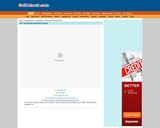
This resource is an interactive SAT matching activity which helps students practice vocabulary skills.
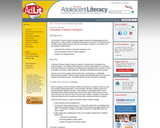
The Semantic Feature Analysis strategy engages students in reading assignments by asking them to relate selected vocabulary to key features of the text. This technique uses a matrix to help students discover how one set of things is related to one another. Use this strategy to help students: understand the meaning of selected vocabulary words; group vocabulary words into logical categories; analyze the completed matrix.
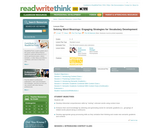
In this lesson, students solve unknown words using context clues, select and generate words for semantic gradients, and develop new semantic gradients and contexts.

In this lesson, students explore dialects and colloquialisms to identify patterns and rules in the English language.

In the magazine article, “The Story of an Eyewitness,†Jack London describes the effects of the San Francisco Earthquake of 1906. His account describes its immediate aftermath and utter destruction of the city by the ensuing fire. The National Archives article provides a brief third-person account of the San Francisco Earthquake that can be used to compare and contrast first- versus third-person accounts of the same event. In this CCSS lesson, students will explore this history through text dependent questions, academic vocabulary, and writing assignments.

A student handout on understanding new vocabulary by using context clues.